When you move your body gently, you trigger powerful biochemical changes that naturally ease anxiety. Your brain releases feel-good chemicals like serotonin and endorphins while reducing stress hormones like cortisol. Simple activities like stretching, walking, or swimming help release physical tension, promote mindfulness, and activate your vagus nerve – a key player in stress response. You don't need special equipment or intense workouts; even 5-10 minutes of gentle movement daily can make a difference. Starting small with enjoyable movements you can do at home builds confidence and creates lasting positive changes. There's much more to discover about this natural anxiety-relief approach.
The Science Behind Movement Benefits
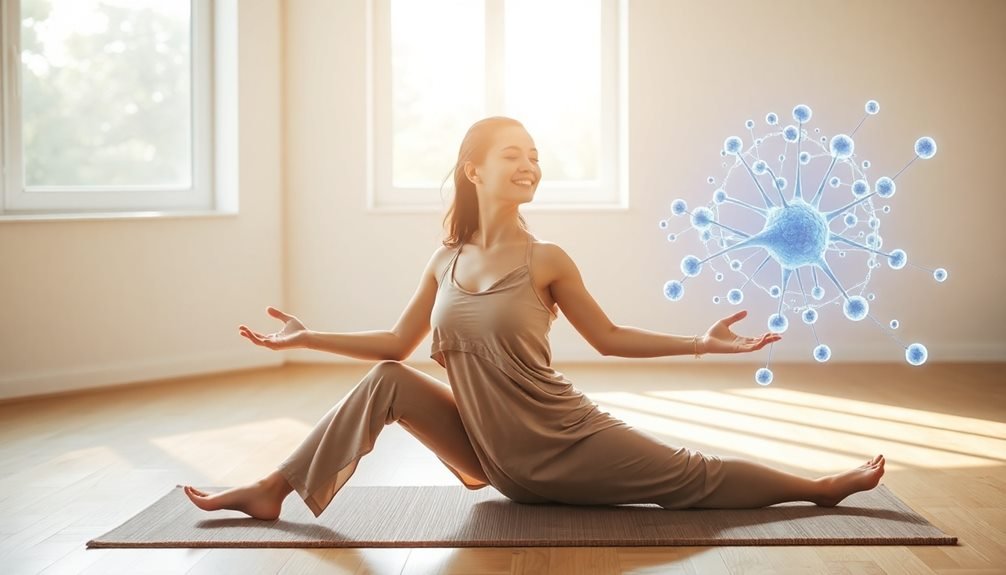
Research demonstrates that physical movement triggers a cascade of biochemical reactions in the brain, releasing essential neurotransmitters like serotonin, dopamine, and endorphins.
These natural mood enhancers help reduce stress hormones like cortisol while promoting feelings of well-being and relaxation. Even gentle forms of movement can activate these beneficial chemical changes, making them particularly suitable if you're dealing with anxiety.
When you engage in slow, mindful movement, you're also stimulating your vagus nerve, which plays a significant role in your body's stress response system.
This activation helps shift your nervous system from "fight or flight" to "rest and digest" mode, lowering your heart rate and blood pressure. The rhythmic nature of gentle movement, such as walking or stretching, can synchronize your breathing patterns and improve oxygen flow to your brain.
Scientists have found that regular movement creates new neural pathways and increases brain plasticity, enhancing your ability to manage stress and anxiety over time.
These neurological changes don't require intense exercise – you'll experience benefits from consistent, gentle movement that feels comfortable for your body.
Starting Your Gentle Exercise Journey
Now that you understand the powerful effects of movement on your brain and body, let's focus on taking those first steps.
Begin with just 5-10 minutes of gentle movement daily, choosing activities that feel manageable and enjoyable. Walking around your neighborhood, simple stretches, or swaying to music can serve as perfect starting points.
Pick a consistent time each day for your movement practice – perhaps right after waking up or during your lunch break. You'll find it easier to maintain the habit when it's tied to an existing routine.
Start with movements that don't require special equipment or training: shoulder rolls, ankle rotations, or gentle neck stretches can all be done from your desk or couch.
If you're feeling particularly anxious, focus on slow, mindful movements paired with deep breathing. Remember that you don't need to achieve any specific fitness goals – the primary aim is to help your nervous system regulate itself.
Listen to your body and adjust the intensity as needed. When movement becomes challenging, remind yourself that even the smallest actions count toward supporting your mental wellbeing.
Walking Mindfully Through Nature

Tranquility awaits in nature's embrace, where mindful walking can help calm an anxious mind. You'll find that combining gentle movement with natural surroundings creates a powerful antidote to stress and worry. As you walk, focus on each step, feeling the ground beneath your feet and the rhythm of your breath.
Choose paths that connect you with the natural world – parks, woodland trails, or quiet neighborhood streets lined with trees. Notice the subtle changes in temperature, the way sunlight filters through leaves, and the gentle sounds of birds or rustling branches. You don't need to walk far or fast; it's about quality of movement rather than distance covered.
To enhance your mindful walking practice:
- Start with short 10-minute walks, gradually increasing duration as you become more comfortable.
- Engage your senses fully – notice smells, textures, sounds, and sights without judgment.
- Set an intention before each walk, whether it's finding peace, clarity, or simply being present.
When thoughts drift to worries, gently guide your attention back to your surroundings and the sensation of walking. This practice becomes easier with time, creating a reliable refuge from anxiety.
Swimming As Moving Meditation
Every stroke through water can transform your swim into a moving meditation, offering a unique combination of gentle resistance and weightless support. As you glide through the water, focus on the rhythm of your breathing and the sensation of water flowing past your skin.
The pool's repetitive environment naturally minimizes external distractions, allowing you to tune into your body's movements. Start with basic freestyle or breaststroke, paying attention to each component of your technique. Notice how your arms pull through the water, how your legs create momentum, and how your core stabilizes your body.
The water's buoyancy reduces joint stress while providing enough resistance to engage your muscles mindfully. If you're new to swimming meditation, try counting your strokes or timing your breaths to create a consistent pattern.
You'll find that the water's constant pressure against your body serves as a natural grounding tool, helping to anchor your awareness in the present moment. When anxious thoughts arise, let them float away like ripples in the pool, returning your focus to the steady tempo of your movement through the water.
Simple Stretches For Mental Relief
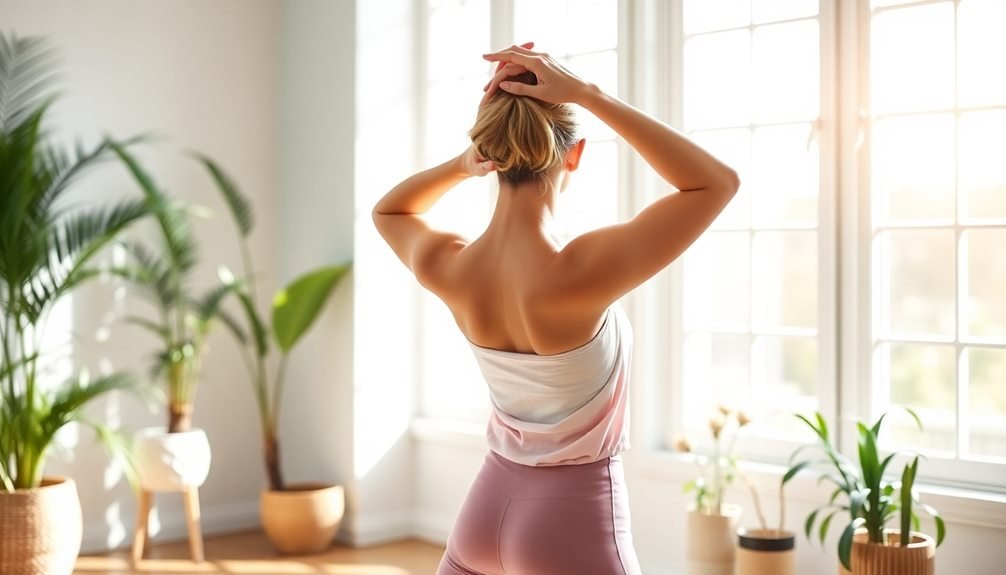
You'll find immediate relief from anxious thoughts through mindful stretching, starting with gentle neck rolls and shoulder drops that help release built-up tension.
Taking your stretching practice to the floor lets you connect more deeply with your body while creating a stable foundation for controlled breathing exercises.
These floor-based movements, from simple spinal twists to leg stretches, work in harmony with your breath to calm your nervous system and quiet your racing mind.
Neck and Shoulder Release
Most people carry stress and tension in their neck and shoulders, creating a physical manifestation of anxiety that can worsen mental distress.
When you're feeling overwhelmed, taking a few minutes to release this built-up tension can help calm both your body and mind. These gentle movements target the areas where anxiety commonly manifests physically.
Start by finding a comfortable seated position, either on a chair or the floor. You'll want to focus on your breath as you move through these tension-relieving exercises. Let your movements be slow and deliberate, never forcing or straining.
- Gentle neck rolls: Drop your chin to chest and slowly circle your head clockwise 3-5 times, then counterclockwise, avoiding backward tilts.
- Shoulder shrugs: Raise your shoulders toward your ears, hold for 3 seconds, then release with an audible exhale, repeating 5-7 times.
- Cross-body shoulder stretch: Bring your right arm across your chest, hold with left arm for 30 seconds, then switch sides.
Remember to breathe deeply throughout these movements, and stop if you experience any pain or discomfort.
You'll likely notice an immediate reduction in tension and anxiety levels.
Floor Stretches While Breathing
Regularly connecting with the ground through gentle floor stretches can create a powerful sense of stability when anxiety feels overwhelming. The firm support beneath you acts as an anchor, helping you focus on your breath and present moment rather than racing thoughts.
Start by lying flat on your back with your knees bent and feet planted firmly on the floor. As you inhale deeply, let your lower back press gently into the ground. Draw your knees toward your chest while exhaling, holding them there for 5-10 breaths. You'll feel your lower back lengthening and releasing tension.
Next, extend your legs straight up toward the ceiling, flexing your feet. Let gravity help you as you gently rock side to side, releasing hip tension. For a deeper stretch, try the figure-four position by crossing one ankle over the opposite thigh, keeping your supporting leg bent.
Remember to move slowly and mindfully, never forcing any position. If you feel discomfort, back off slightly.
These floor stretches work best when you sync them with slow, deliberate breathing – inhaling for four counts, exhaling for six. This rhythm naturally calms your nervous system while the stretches release physical tension.
Building A Sustainable Movement Practice
Developing a lasting movement practice requires both dedication and self-compassion. You'll need to find a balance between pushing yourself to maintain consistency and being gentle when life gets in the way.
Start by choosing movements that feel enjoyable rather than forcing yourself into activities you dread. Your sustainable practice should fit naturally into your daily routine, whether that's morning stretches, lunchtime walks, or evening yoga.
To create a movement practice that sticks, focus on these key elements:
- Start small and build gradually – begin with just 5-10 minutes daily, then increase duration as it becomes habitual.
- Track your progress without judgment – use a simple journal or app to note when you move, how you feel, and what works best.
- Connect movement to existing habits – pair your practice with daily activities like brushing teeth or making coffee.
Remember that consistency matters more than intensity. When you miss a day, simply return to your practice the next day without guilt.
Overcoming Common Exercise Fears
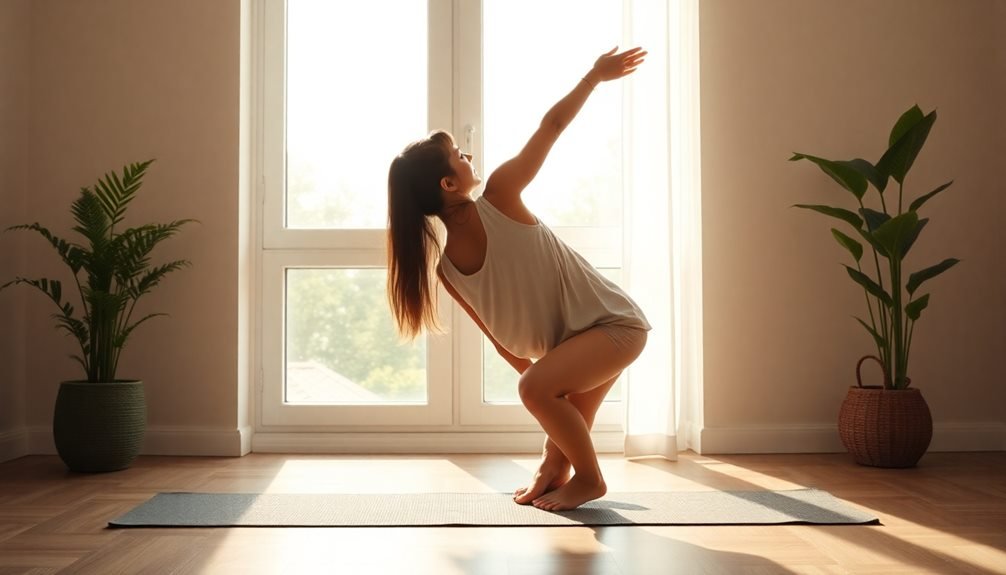
Fear often holds people back from starting a movement practice, especially when anxiety is already present. You might worry about looking awkward, getting injured, or not being "fit enough" to begin. These concerns are normal, but they shouldn't prevent you from experiencing the benefits of gentle movement.
| Common Fear | Reality Check | Action Step |
|---|---|---|
| Looking foolish | Everyone starts as a beginner | Start at home or in quiet spaces |
| Getting hurt | Gentle movement is low-risk | Begin with basic stretches |
| Being "too unfit" | Movement adapts to your level | Focus on what you can do today |
You can overcome these exercise fears by starting small and building confidence gradually. Try five minutes of gentle stretching in your bedroom, or take a short walk around your block when fewer people are out. Remember that your movement practice is personal – there's no need to compare yourself to others or push beyond your comfort zone too quickly. If you're concerned about form or safety, consider working with a qualified instructor who specializes in gentle movement or anxiety-informed exercise practices.
Frequently Asked Questions
Can Certain Movements Trigger Anxiety Instead of Reducing It?
Yes, you'll find that sudden, intense, or overwhelming movements can spike your anxiety levels. Quick jerks, fast spins, or complex routines may increase your heart rate and trigger panic sensations in your body.
What Role Does Breathing Play When Combining Movement With Anxiety Management?
Your breath serves as an anchor during movement, helping you stay present and calm. When you sync breathing with gentle motions, you'll naturally reduce stress levels and create a mind-body connection that eases anxiety.
How Long Should Beginners Rest Between Gentle Movement Sessions?
You'll want to rest 24-48 hours between movement sessions as a beginner. Listen to your body – if you're feeling sore or fatigued, take an extra day before your next gentle exercise session.
Are There Specific Times of Day When Movement Helps Anxiety More?
You'll find morning movement most effective for reducing anxiety, as it sets a positive tone for your day. Evening gentle exercises can also help calm your mind before bed, but avoid vigorous activity late.
Should Gentle Movements Be Done Alone or With Others for Best Results?
You'll benefit from both solo and group movement – it depends on your comfort level. If you're feeling social, group classes can provide support, while solo practice lets you focus entirely on your personal experience.
In Summary
You've taken an important step in understanding how gentle movement can calm your anxious mind. Whether you're walking in nature, swimming laps, or stretching at home, you're building valuable tools for mental wellness. Remember, you don't need intense workouts to feel better – consistent, mindful movement is key. Start small, listen to your body, and you'll develop a sustainable practice that supports your emotional wellbeing.
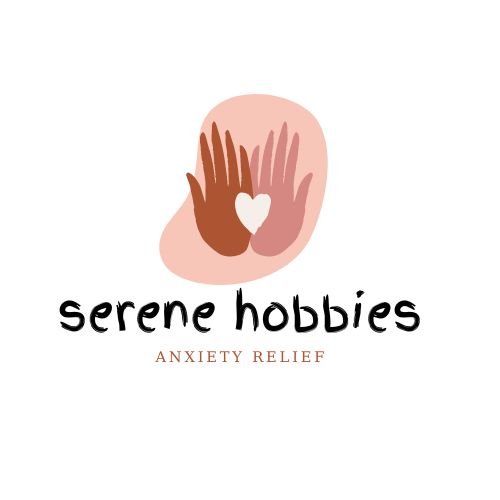
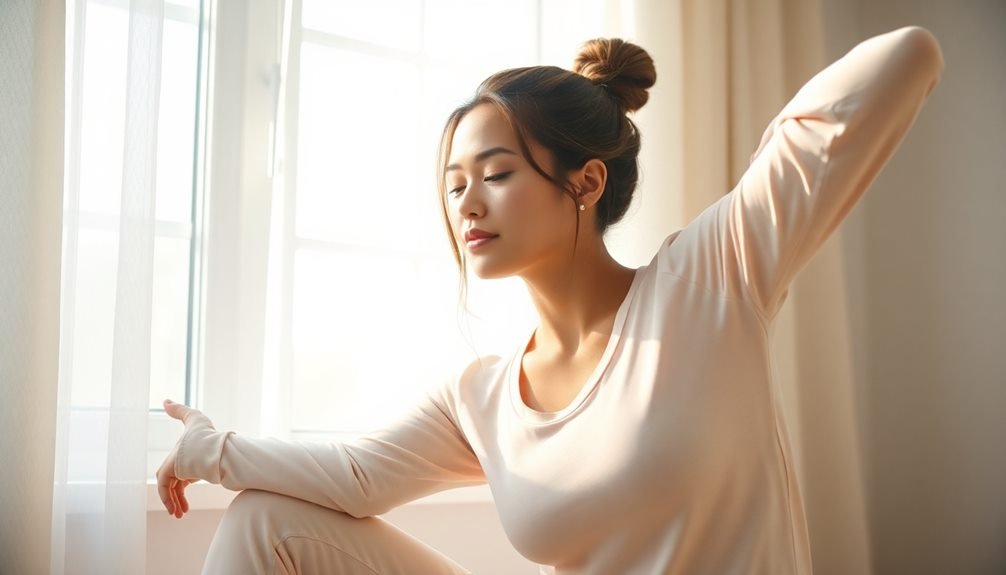
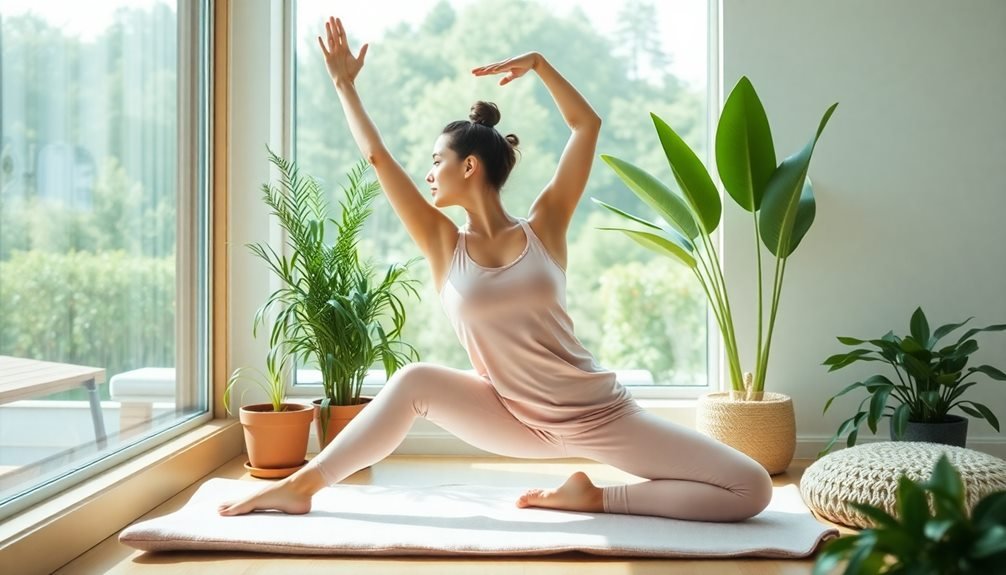
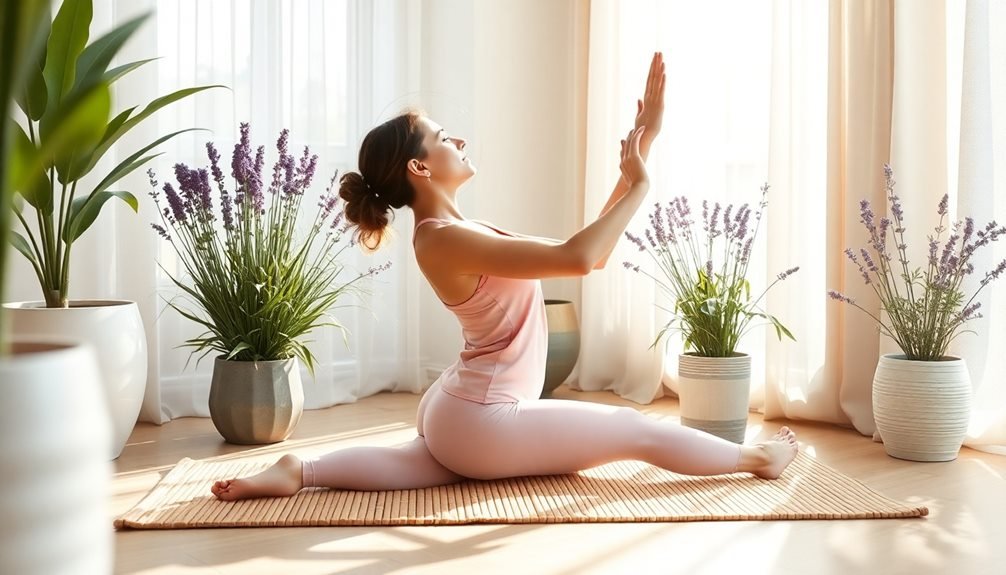
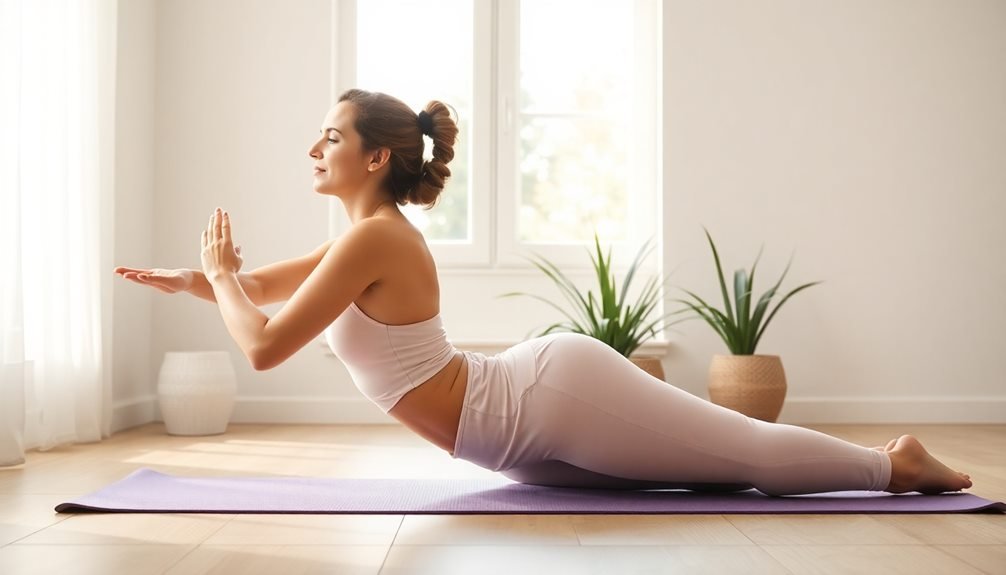
Leave a Reply